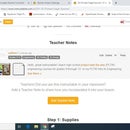Introduction: How to Make a Exploding Outhouse!
Intro
I am a high school engineering teacher who received two 3D printers this school year (2017-18). My students and I were very excited about using them, so I wanted to create a fun design project that implemented the 3D printers for my drafting & design technology students. When I was brainstorming ideas, I remembered how my grandpa used to make these little wooden outhouses that exploded when you would drop a coin in the cut out hole on the top of them.
Unfortunately, I could not find the wooden one that my grandpa gave my family when I was a kid, so I began prototyping!
After evaluating and editing my design, I developed one that worked!
As I mentioned, I am an engineering teacher and therefore I preach proper documentation to my students, especially when it comes to dimensioning their blueprints. With this being my first instructable, I hope it is clear and precise!
How the exploding outhouse works
The outhouse is comprised of six 3D printed parts: 2 walls, 1 roof, 1 floor, 1 front door, and 1 back door. You also superglue the mouse trap into the base of the floor. Once assembled, the mousetrap will be 'set' on the inside. When someone drops a coin in from the top, the coin triggers the mousetrap of which goes off a hits two prongs that are opposite of each other on the inside of the walls. Then Kaboom, the outhouse explodes and usually scares its victim.
How the project is implemented in STEM education
I implemented my design by having my students reverse engineering my final product. Therefore, they took apart my outhouse, measured each part with calipers and build them on Autodesk Inventor. I embossed the words “Sedville,” “Outhouse,” and a crescent moon on my design, but I encouraged my student to emboss their own designs/words if they wished. "Sedville," is the previous name of my town; decades ago when outhouses were more common.
Materials
3D Printer & filament (I used Lulzbot’s TAZ 6 & Polylite PLA filament)
CAD software (I used Autodesk Inventor)
Victor Mouse Trap
Gorilla Super Glue
1 Coin
*Note* this project is totally customizable. Feel free to make it out of wood if you wish like my grandpa once did. Feel free to experiment with other filaments too! I look forward to seeing what you guys come up with.
Recommendations for wood
If you decide to make your outhouse out of wood, I recommend that you use 5/8” screws for your prongs. Also, after you have inserted your screws, I recommend covering the end of the screw with some type of small tubing as seen here. I recommend the screw tubing because when the mouse trap goes off, it will not catch the threads on the screw, and therefore will produce a better explosion.
Terms/Symbols Used
Emboss – a tool on Autodesk Inventor where you can engrave and/or extrude words and/or 2D shapes.
"R." - stands for the radius of a circular feature on an object
"Ø" - stands for the diameter of a circular feature on an object
Step 1: Create 3D Parts
As long as you know how to read blueprints and how to measure, you should be good to go! If you do not know how to use a type of CAD software, I highly recommend creating it out of wood; stain it and make it look real nice! All of the dimensions are in inches.
Step 2: Glue in the Mouse Trap
Super glue the mouse trap to the built-in indention in the base of your floor. If you build it according to my blueprints, the mousetrap should be centered on the floor. I used gorilla super glue. The mousetrap might be a tight fit, but it should work.
Step 3: Assembling
Be careful when you assemble your outhouse so that you do not accidentally activate the mousetrap.
Step A:
Set the mousetrap.
Step B:
Insert the walls where the prongs are directly above the mouse trap's hammer. The hammer is the piece of metal that flips and hits the mouse when triggered.
Step C:
Carefully insert the back door and front door when pinching the walls, as seen in the photos. I recommend pinching the walls so that the doors do not fall in on you and accidentally activate your mousetrap.
Step: D:
Carefully rest the roof on top of the outhouse, so that the bars are resting on the outside of your walls and doors, as seen in the photos.
Step 4: Video

Participated in the
Epilog Challenge 9

Participated in the
First Time Author Contest 2018









